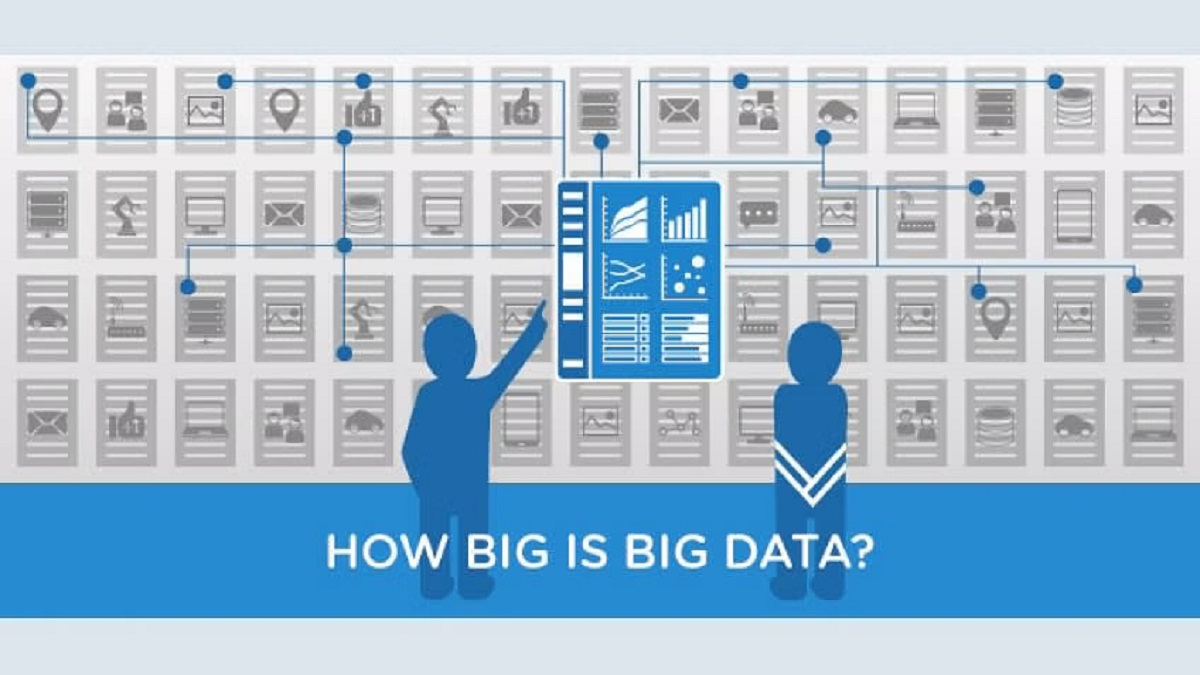Introduction
In today’s digital age, the world is inundated with an unprecedented amount of data. From social media posts and online transactions to sensor readings and customer behavior patterns, the volume, velocity, and variety of data being generated are staggering. This sheer amount of information is collectively known as “big data.” However, what sets big data apart is not just its scale but also its potential value.
Big data has revolutionized the way businesses operate and make decisions. By harnessing the power of advanced analytics and technologies, organizations can unlock insights and gain a competitive edge in the marketplace. Big data analytics enables businesses to make data-driven decisions, uncover patterns, and identify trends that may otherwise go unnoticed. This invaluable resource has become a game-changer across various industries, offering a plethora of benefits.
In this article, we will explore the numerous benefits that big data brings to organizations. From improved decision-making and cost reduction to customer insights and process optimization, we will delve into the different ways big data can transform businesses, leading to greater success and growth.
Improved Decision Making
One of the key benefits of big data is its ability to enhance decision making within organizations. Traditional decision-making processes often rely on limited information and intuition, which can lead to suboptimal outcomes. However, big data analytics provides businesses with a wealth of information, enabling them to make data-driven decisions based on facts and patterns.
By analyzing large volumes of data from various sources, organizations can gain deeper insights into customer preferences, market trends, and business performance. This information can then be used to make more informed decisions that align with the needs and expectations of customers. For example, retailers can analyze sales data to identify which products are in high demand, allowing them to adjust their inventory accordingly and maximize profits.
Moreover, big data analytics can help businesses identify new business opportunities, evaluate potential risks, and optimize resource allocation. By analyzing historical data and real-time information, organizations can detect patterns and trends that may be crucial for making strategic decisions. This proactive approach to decision making can help businesses stay ahead of the competition and seize new opportunities in a rapidly changing market.
In addition, big data analytics can enable organizations to conduct predictive analysis, providing insights into future scenarios and outcomes. By leveraging algorithms and machine learning models, businesses can forecast consumer behavior, market trends, and potential risks. This allows them to make proactive decisions and develop strategies to mitigate risks and capitalize on emerging trends.
Overall, improved decision making is a significant benefit of big data analytics. By harnessing the power of data, businesses can make informed, strategic decisions that lead to better outcomes, increased efficiency, and ultimately, greater success.
Cost Reduction
Big data analytics can have a profound impact on cost reduction within organizations. By analyzing large volumes of data, businesses can uncover inefficiencies, identify cost-saving opportunities, and optimize their operations.
One of the ways big data helps reduce costs is through predictive maintenance. By analyzing sensor data from machinery and equipment, organizations can detect patterns and trends that indicate potential failures. This allows them to proactively schedule maintenance and repairs, minimizing downtime and avoiding costly breakdowns. In turn, this reduces repair and replacement costs and ensures that operations run smoothly.
Furthermore, big data analytics can help identify areas of unnecessary expenditure. By analyzing spending patterns, organizations can pinpoint areas where costs can be trimmed, such as reducing energy consumption, streamlining supply chain logistics, or optimizing inventory management. This optimization can lead to significant cost savings and improved efficiency throughout the organization.
Additionally, big data analytics can help businesses optimize pricing strategies. By analyzing market data, customer behavior, and competitive dynamics, organizations can determine the optimal pricing for their products or services. This ensures that prices remain competitive while maximizing profitability. By continuously monitoring and adjusting pricing strategies based on real-time data, businesses can adapt to market fluctuations and consumer demand, further driving cost reduction and revenue optimization.
Finally, big data analytics can help organizations identify and prevent fraud and financial losses. By analyzing transactional data and patterns of fraudulent behavior, businesses can detect and prevent fraudulent activities, reducing financial losses and protecting their bottom line. This is particularly relevant in industries such as banking and finance, where fraud detection and prevention are paramount.
In summary, big data analytics plays a crucial role in cost reduction for organizations. By leveraging data insights, businesses can identify inefficiencies, optimize operations, streamline processes, and prevent financial losses, leading to significant cost savings and improved profitability.
Customer Insights
Understanding customers is vital for any business to succeed. Big data analytics provides organizations with unparalleled customer insights, allowing them to better understand their target audience and cater to their needs and preferences.
By analyzing customer data, businesses can gain valuable insights into their buying behavior, preferences, and demographics. This information can be used to segment customers into different groups based on their characteristics and preferences. This segmentation enables businesses to create more targeted marketing campaigns, personalized product recommendations, and tailored offerings that resonate with specific customer segments.
Big data analytics also helps organizations identify patterns and trends in customer behavior. By tracking and analyzing customer interactions across various channels, businesses can gain insight into customer preferences, buying patterns, and decision-making processes. For example, tracking website traffic and analyzing clickstream data can reveal which products or services are most popular, enabling businesses to optimize their offerings and marketing strategies accordingly.
Moreover, big data analytics allows organizations to monitor and analyze customer feedback, such as social media posts, reviews, and surveys. This feedback provides valuable insights into customer satisfaction, product improvements, and areas for innovation. By utilizing sentiment analysis techniques, businesses can gain a deeper understanding of customer sentiments and adapt their strategies accordingly.
Furthermore, big data enables businesses to personalize their marketing efforts and deliver customized experiences to customers. By leveraging data on customer preferences, interests, and past interactions, organizations can create personalized marketing messages, targeted advertisements, and tailored recommendations. This personalization not only enhances customer engagement and loyalty but also improves the overall customer experience.
In summary, big data analytics provides businesses with invaluable customer insights. By analyzing and leveraging customer data, organizations can understand their customers better, segment them effectively, deliver personalized experiences, and tailor their offerings, resulting in increased customer satisfaction and business success.
Process Optimization
Process optimization is a crucial aspect of driving efficiency and productivity within organizations. Big data analytics plays a significant role in identifying areas of improvement and streamlining processes to enhance overall performance.
By analyzing operational data, businesses can gain insights into process bottlenecks, inefficiencies, and areas of improvement. This data-driven approach allows organizations to identify the root causes of process issues and implement targeted solutions. For example, analyzing manufacturing data can reveal inefficiencies in production lines, enabling businesses to optimize workflows, reduce waste, and improve overall efficiency.
Additionally, big data analytics can help organizations optimize their supply chain management. By analyzing data on supplier performance, logistics, inventory levels, and demand patterns, businesses can make informed decisions to improve the entire supply chain process. This includes aspects such as demand forecasting, inventory management, and supplier selection, leading to improved efficiency, reduced costs, and increased customer satisfaction.
Furthermore, big data analytics can help enhance customer service processes. By analyzing customer interaction data, businesses can identify common issues and pain points, allowing for targeted improvements to be made. For example, analyzing customer support call data can reveal recurring problems, enabling businesses to implement solutions that address these issues proactively. This not only improves customer satisfaction but also reduces the load on customer support teams.
Moreover, big data analytics enables organizations to monitor and optimize their operational performance in real-time. By collecting and analyzing data from various sources such as sensors, machines, and IoT devices, businesses can gain real-time insights into operational efficiency, machine performance, and maintenance needs. This allows for proactive maintenance, predictive analysis, and continuous process improvements, resulting in increased productivity and reduced downtime.
In summary, big data analytics empowers organizations to optimize their processes by identifying bottlenecks, streamlining workflows, and improving overall efficiency. By leveraging data insights, businesses can make data-driven decisions, enhance operational performance, and drive continuous improvement throughout the organization.
New Product Development
Big data analytics has revolutionized the process of new product development, enabling organizations to create innovative and successful products that resonate with their target market.
One of the ways big data supports new product development is through market research and consumer insights. By analyzing vast amounts of data on consumer preferences, purchasing behavior, and market trends, businesses can identify unmet needs and uncover opportunities for new product development. This data-driven approach ensures that new products are aligned with customer expectations and have a higher chance of success in the market.
Additionally, big data analytics enables businesses to gather feedback on existing products or prototypes. By monitoring social media channels, customer reviews, and feedback surveys, organizations can collect valuable insights and make necessary improvements to enhance the product’s features, usability, and overall customer experience. This iterative feedback loop fosters continuous improvement and increases the likelihood of success for new products.
Furthermore, big data analytics can support the process of product design and customization. By analyzing customer preferences, trends, and usage patterns, businesses can create personalized and tailored products that meet the specific needs of individual customers. This level of customization not only enhances customer satisfaction but also provides a competitive edge in the market.
Moreover, big data analytics can help organizations forecast demand and optimize pricing strategies for new products. By leveraging historical sales data, market trends, and competitor analysis, businesses can determine the pricing strategies that maximize profitability while remaining competitive. Additionally, the ability to predict demand enables businesses to plan production and inventory levels more accurately, minimizing costs and optimizing resources.
Overall, big data analytics plays a pivotal role in new product development by providing insights into market trends, consumer preferences, and demand patterns. By leveraging these insights, businesses can create innovative products, tailor them to specific customer needs, and optimize pricing strategies, increasing the chances of success in the market.
Competitive Advantage
In today’s competitive business landscape, gaining a competitive edge is crucial for success. Big data analytics provides organizations with a powerful tool to gain insights, make informed decisions, and differentiate themselves from competitors.
One of the ways big data analytics offers a competitive advantage is through market intelligence. By analyzing vast amounts of data on market dynamics, consumer behavior, and competitor strategies, businesses can gain a deep understanding of the market landscape. This allows them to identify emerging trends, spot opportunities, and make strategic decisions that give them an edge over competitors.
Additionally, big data analytics enables organizations to improve their customer targeting and acquisition strategies. By analyzing customer data, businesses can identify the most profitable customer segments, understand their preferences, and develop targeted marketing campaigns. This focused approach allows businesses to reach the right customers with the right message at the right time, increasing customer acquisition and retention rates.
Furthermore, big data analytics can help businesses optimize their pricing strategies. By leveraging data on market trends, competitor pricing, and customer preferences, organizations can determine the optimal pricing that maximizes profitability while remaining competitive. This can help businesses attract price-sensitive customers and maintain a competitive position in the market.
Moreover, big data analytics enables organizations to improve their operational efficiency. By analyzing data on production processes, supply chain logistics, and resource allocation, businesses can identify areas of inefficiency and optimize their operations. This leads to cost savings, improved productivity, and better customer service, all of which contribute to a competitive advantage.
Additionally, big data analytics can foster innovation and product development. By analyzing market trends, customer feedback, and emerging technologies, organizations can identify opportunities to develop new products or enhance existing ones. This ability to innovate and quickly respond to changing market demands allows businesses to stay ahead of the competition and differentiate themselves in the market.
In summary, big data analytics provides organizations with the tools and insights they need to gain a competitive advantage. By leveraging data to gain market intelligence, optimize customer targeting and pricing strategies, improve operational efficiency, and foster innovation, businesses can differentiate themselves and position themselves for success in a competitive marketplace.
Risk Analysis
Effective risk analysis is essential for businesses to mitigate potential threats and uncertainties. Big data analytics plays a critical role in identifying, assessing, and managing risks, allowing organizations to make informed decisions and protect their interests.
One of the ways big data analytics supports risk analysis is through the identification of patterns and anomalies. By analyzing large volumes of data, businesses can detect unusual trends or behaviors that may indicate potential risks. For example, by analyzing financial transactions, organizations can identify patterns of fraudulent activities or suspicious transactions, enabling them to take preventive measures to minimize financial risks.
Additionally, big data analytics enables organizations to conduct predictive risk analysis. By utilizing historical data, market trends, and predictive modeling, businesses can identify potential future risks and take proactive measures to mitigate them. This allows for better risk assessment and helps organizations develop contingency plans to handle potential disruptions.
Big data analytics also supports risk analysis in supply chain management. Organizations can analyze data on supplier performance, logistics, and demand patterns to identify potential risks and vulnerabilities in the supply chain. This allows businesses to take necessary measures to ensure continuity, such as identifying alternative suppliers or establishing redundancy in the supply chain.
Furthermore, big data analytics can help organizations assess and manage operational risks. By analyzing data on operational processes, machine performance, and employee behavior, businesses can identify areas of potential risk and implement strategies to mitigate them. For example, predictive maintenance based on sensor data analysis can help prevent equipment failures, minimizing production downtime and associated financial risks.
Moreover, big data analytics can support risk analysis in the financial sector. By analyzing financial data, market trends, and economic indicators, businesses and financial institutions can assess credit risks, market risks, and liquidity risks. This enables them to make informed decisions about investment strategies, loan approvals, and risk management practices.
In summary, big data analytics is a powerful tool for risk analysis. By leveraging data insights, businesses can identify potential risks, assess their impact, and develop strategies to mitigate them. This proactive approach to risk management helps organizations protect their interests, minimize financial and operational disruptions, and make informed decisions in an uncertain business environment.
Personalized Marketing
In today’s competitive marketplace, personalized marketing has become a key strategy for businesses to engage with their customers on a deeper level. Big data analytics plays a crucial role in enabling organizations to deliver targeted and personalized marketing campaigns that resonate with individual customers.
By analyzing vast amounts of customer data, businesses can gain valuable insights into customer preferences, interests, and behaviors. This information allows organizations to segment their customer base and create targeted marketing campaigns for specific customer segments. Personalized marketing messages are more likely to capture the attention of customers and drive higher engagement and conversion rates.
Big data analytics also enables organizations to deliver personalized product recommendations. By analyzing customer purchase history, browsing behavior, and demographic information, businesses can provide tailored suggestions that match individual preferences. This enhances the customer experience and increases the likelihood of repeat purchases.
Furthermore, big data analytics enables businesses to leverage real-time data to deliver personalized marketing messages. By analyzing data from social media, mobile apps, and website interactions, organizations can create personalized offers, discounts, and promotions that are relevant to the customer’s current preferences and context. This real-time personalization strengthens the connection between businesses and customers and enhances customer loyalty.
Additionally, big data analytics can help organizations optimize their marketing channels and budget allocation. By analyzing data on customer response rates, conversion rates, and customer lifetime value, businesses can identify the most effective marketing channels for different customer segments. This allows for more precise targeting and efficient use of marketing resources, resulting in higher ROI for marketing campaigns.
Moreover, big data analytics enhances customer journey mapping and customer experience optimization. By analyzing customer touchpoints and interactions, businesses can understand the customer journey and identify pain points or areas for improvement. This valuable insight enables organizations to tailor their marketing efforts to address customer needs at various stages of the buying process, resulting in a seamless and personalized customer experience.
In summary, big data analytics empowers organizations to deliver personalized marketing experiences to their customers. By leveraging customer data insights, businesses can create targeted campaigns, deliver personalized recommendations, optimize marketing channels, and enhance the overall customer experience. This personalized approach builds stronger customer relationships, increases customer satisfaction, and drives business growth.
Better Customer Service
Customer service is a critical component of business success, and big data analytics has revolutionized the way organizations deliver customer service. By leveraging customer data and advanced analytics, businesses can provide better customer service experiences that meet and exceed customer expectations.
One of the ways big data analytics improves customer service is by enabling organizations to gain a deeper understanding of their customers. By analyzing customer data, businesses can identify customer preferences, behavior patterns, and historical interactions. This information allows organizations to provide personalized and proactive customer service, anticipating customer needs and resolving issues quickly.
Big data analytics also helps organizations enhance their customer support operations. By analyzing customer service data, such as call logs, chat transcripts, and support tickets, businesses can identify common customer issues and pain points. This insight enables organizations to optimize their support processes, provide faster and more efficient resolutions, and improve overall customer satisfaction.
Additionally, big data analytics facilitates sentiment analysis, allowing businesses to understand and address customer sentiments effectively. By analyzing customer feedback from various channels, such as social media, online reviews, and surveys, organizations can gain insights into customer satisfaction levels, sentiment trends, and areas for improvement. This knowledge can help businesses make necessary changes to enhance customer experiences and strengthen relationships.
Moreover, big data analytics enables businesses to implement self-service options for customers. By analyzing customer behavior and preferences, organizations can develop self-service portals, chatbots, and knowledge bases that provide information and solutions for common customer inquiries. This empowers customers to find answers independently, reducing the need for human intervention and improving the efficiency of customer service operations.
Furthermore, big data analytics supports real-time customer service. By leveraging data from various touchpoints, such as website interactions, mobile app usage, and purchase behavior, organizations can provide personalized and context-aware customer service in real-time. This allows businesses to offer relevant recommendations, address concerns promptly, and provide a seamless customer service experience.
In summary, big data analytics enhances customer service by providing businesses with insights into customer preferences, optimizing support processes, analyzing customer sentiment, implementing self-service options, and delivering real-time personalized service. By leveraging these capabilities, organizations can deliver better customer service experiences, increase customer satisfaction, and foster long-term customer loyalty.
Conclusion
In today’s data-driven world, big data analytics has proven to be a game-changer for businesses across various industries. The benefits of big data are abundant and far-reaching, impacting every aspect of an organization’s operations. From improved decision-making and cost reduction to customer insights, process optimization, new product development, competitive advantage, risk analysis, personalized marketing, and better customer service, big data analytics has reshaped the way businesses operate and interact with their customers.
By leveraging the power of advanced analytics and technologies, organizations can harness the wealth of data at their disposal to make informed decisions, optimize processes, and enhance the overall customer experience. The ability to analyze vast amounts of data enables businesses to uncover patterns, identify trends, and gain valuable insights that were previously unimaginable.
Through improved decision-making, organizations can make strategic choices that align with customer needs and market trends, ultimately driving success and growth. Cost reduction becomes achievable through the identification of inefficiencies, optimization of operations, and better resource allocation. Customer insights empower businesses to understand their audience better, deliver personalized experiences, and create products and services that truly resonate.
Process optimization allows for increased efficiency, streamlined workflows, and better supply chain management. New product development becomes more targeted and successful with market intelligence and consumer insights. Gaining a competitive advantage becomes feasible through data-driven decision-making, better customer targeting, and operational efficiency.
Risk analysis ensures that organizations can anticipate and mitigate potential threats and disruptions, protecting their interests. Personalized marketing enables businesses to deliver targeted and relevant messages to customers, fostering engagement and loyalty. Better customer service is achieved through understanding customer needs, proactive problem-solving, and real-time support.
In conclusion, big data analytics provides businesses with an invaluable resource to thrive in the digital era. By harnessing the power of data, organizations can unlock opportunities, optimize operations, enhance the customer experience, and stay ahead of the competition. Embracing big data analytics is no longer an option but a necessity for businesses that want to remain relevant, efficient, and customer-centric in a rapidly evolving market.

























